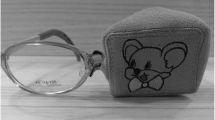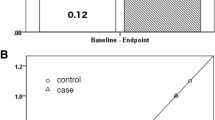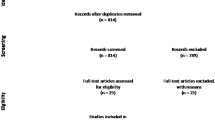Abstract
Purpose
To investigate the effects of full-time patching regimen on the treatment of amblyopia in children aged 10–16 years.
Methods
Forty-seven patients with a mean age of 12.09 ± 1.65 years were included in this study. All of the patients received eye patching for the entire day, 6 days a week, during the first 3 months. The patients who achieved visual acuity of 0.00 logMAR at the third month were provided with additional patching treatment (4–6 h/day). On the other hand, the patients who showed no change in their visual acuity or an increase of less than 0.00 logMAR at the third month had 3 more months of eye patching for the entire day, 6 days a week.
Results
Prior to treatment, the best mean visual acuity of the amblyopic eyes was 0.48 ± 0.25 (range 1.00–0.15) logMAR. After follow-up, the visual acuity of the amblyopic eyes was 0.20 ± 0.22 (range 1.00–0.00) logMAR. Thus, visual acuity in the amblyopic eyes improved by 0.2 log unit or more in 38 of 47 patients (81%).
Conclusions
The present results show that patching in older children with amblyopia improves visual acuity with no serious complications. The use of patching in children to improve amblyopia seems promising.

Similar content being viewed by others
References
Assaf AA. The sensitive period: transfer of fixation after occlusion for strabismic amblyopia. Br J Ophthalmol. 1982;66:64–70.
Epelbaum M, Milleret C, Buisseret P, Dufier JL. The sensitive period for strabismic amblyopia in humans. Ophthalmology. 1993;100:323–7.
Vereecken EP, Brabant P. Prognosis for vision in amblyopia after the loss of the good eye. Arch Ophthalmol. 1984;102:220–4.
Simmers AJ, Gray LS. Improvement of visual function in an adult amblyope. Optom Vis Sci. 1999;76:82–7.
Pediatric Eye Disease Investigator Group. A prospective, pilot study of treatment of amblyopia in children 10 to <18 years old. Am J Ophthalmol. 2004;137:581–3.
Mohan K, Saroha V, Sharma A. Successful occlusion therapy for amblyopia in 11- to 15-year-old children. J Pediatr Ophthalmol Strabismus. 2004;41:89–95.
Oliver M, Neumann R, Chaimovitch Y, Gotesman N, Shimshoni M. Compliance and results of treatment for amblyopia in children more than 8 years old. Am J Ophthalmol. 1986;102:340–5.
Mintz-Hittner HA, Fernandez KM. Successful amblyopia therapy initiated after age 7 years: compliance cures. Arch Ophthalmol. 2000;118:1535–41.
Wick B, Wingard M, Cotter S, Scheiman M. Anisometropic amblyopia: is the patient ever too old to treat? Optom Vis Sci. 1992;69:866–78.
Park KH, Hwang J-M, Ahn JK. Efficacy of amblyopia therapy initiated after 9 years of age. Eye (Lond). 2004;18:571–4.
Pediatric Eye Disease Investigator Group. Randomized trial of treatment of amblyopia in children aged 7 to 17 years. Arch Ophthalmol. 2005;123:437–47.
Loudon SE, Simonsz HJ. The history of the treatment of amblyopia. Strabismus. 2005;13:93–106.
Wright KW, Edelman PM, Walonker F, Yiu S. Reliability of fixation preference testing in diagnosing amblyopia. Arch Ophthalmol. 1986;104:549–53.
Gallaway M, Scheiman M. Assessment of accommodative facility using MEM retinoscopy. J Am Optom Assoc. 1990;61(1):36–9.
Oliver M, Nawratzki I. Screening of pre-school children for ocular anomalies. II. Amblyopia. Prevalence and therapeutic results at different ages. Br J Ophthalmol. 1971;55:467–71.
Repka MX, Kraker RT, Beck RW, Birch E, Cotter SA, Holmes JM et al. Treatment of severe amblyopia with atropine: results from 2 randomized clinical trials. J AAPOS. 2009;13(5):529.
Pediatric Eye Disease Investigator Group. Two-year follow-up of a 6-month randomized trial of atropine vs patching for treatment of moderate amblyopia in children. Arch Ophthalmol. 2005;123:149–57.
Pediatric Eye Disease Investigator Group. Impact of patching and atropine treatment on the child and family in the amblyopia treatment study. Arch Ophthalmol. 2003;121:1625–32.
Lithander J, Sjöstrand J. Anisometropic and strabismic amblyopia in the age group 2 years and above: a prospective study of the results of treatment. Br J Ophthalmol. 1991;75:111–6.
Loudon SE, Polling JR, Simonsz HJ. A preliminary report about the relation between visual acuity increase and compliance in patching therapy for amblyopia. Strabismus. 2002;10:79–82.
Campos E. Amblyopia. Surv Ophthalmol. 1995;40:23–39.
Moseley MJ, Neufeld M, McCarry B, Charnock A, McNamara R, Rice T, et al. Remediation of refractive amblyopia by optical correction alone. Ophthalmic Physiol Opt. 2002;22:296–9.
Stewart CE, Moseley MJ, Fielder AR, Stephens DA; MOTAS Cooperative. Refractive adaptation in amblyopia: quantification of effect and implications for practice. Br J Ophthalmol. 2004;88:1552–6.
Author information
Authors and Affiliations
Corresponding author
Additional information
This study was conducted at the Ankara Training and Research Hospital Department of Ophthalmology.
About this article
Cite this article
Erdem, E., Çınar, G.Y., Somer, D. et al. Eye patching as a treatment for amblyopia in children aged 10–16 years. Jpn J Ophthalmol 55, 389–395 (2011). https://doi.org/10.1007/s10384-011-0029-z
Received:
Accepted:
Published:
Issue Date:
DOI: https://doi.org/10.1007/s10384-011-0029-z




